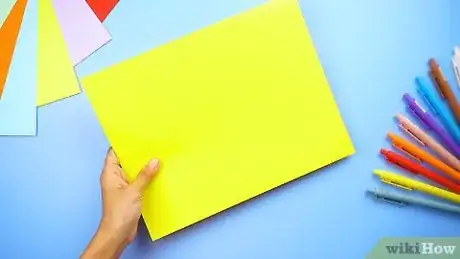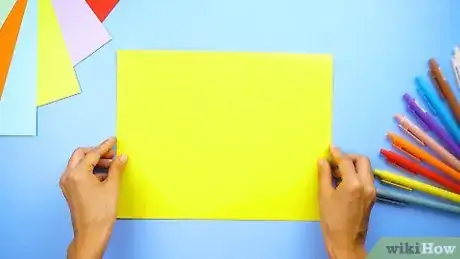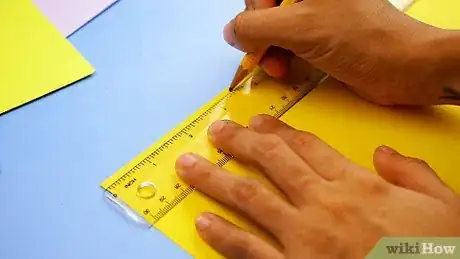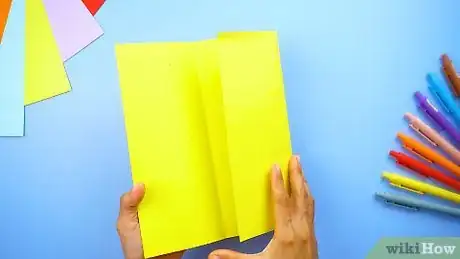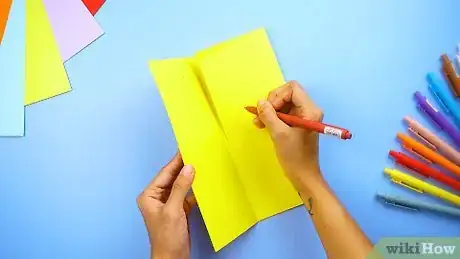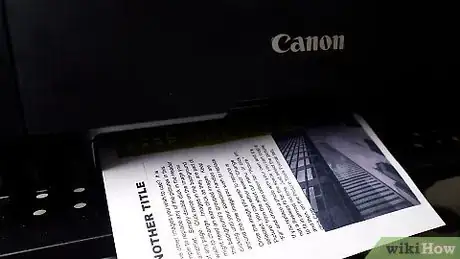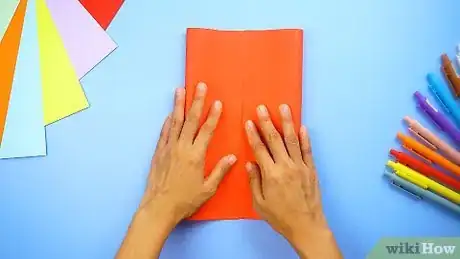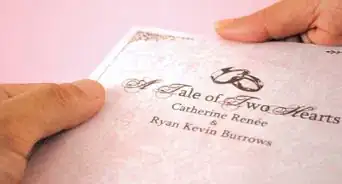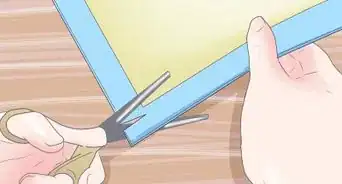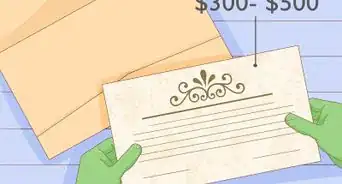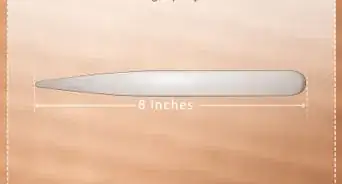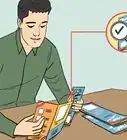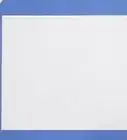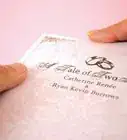This article was co-authored by wikiHow Staff. Our trained team of editors and researchers validate articles for accuracy and comprehensiveness. wikiHow's Content Management Team carefully monitors the work from our editorial staff to ensure that each article is backed by trusted research and meets our high quality standards.
The wikiHow Video Team also followed the article's instructions and verified that they work.
This article has been viewed 560,420 times.
Learn more...
A tri fold brochure is a great way to organize a lot of information onto a single sheet of paper. This type of leaflet is incredibly easy to make and, once you get the technique down, you’ll be able to branch out into more unique styles like the z-fold brochure.
Steps
Folding Your Brochure
-
1Get an 8 1⁄2 by 11 in (22 by 28 cm) sheet of paper. If you plan on printing your brochure, you should design it on your computer first, then print it out. Click here to learn how. If you wish to write and draw on your brochure by hand, then get out your paper and keep on reading!
- Heavier paper, such as cardstock will look nicer, but you can use other types of paper too such as construction or printer paper.
-
2Place the paper on a flat surface and orient it landscape style. The short edges should be on the left and right sides of the paper. One of the long edges should be facing you. If you have already written on the paper, make sure that the side you want to be on the inside is facing you.Advertisement
-
3Divide the paper into thirds using a pencil and ruler. Place a ruler along the top edge of the paper. Make 2 marks along the top edge of the paper. The first mark should be 1/3 of the way across the ruler, and the second mark should be 2/3 of the way across.[1]
-
4Fold the right side of the paper to the middle using the pencil mark as a guide. Slowly fold the right side of the paper 1/3 of the way, using your pencil mark as a guide. Make sure that the top and bottom edges of the top layer of paper match up with the bottom layer of the paper. Sharpen the crease by running your fingernail across it.[4]
- If you made both marks at exactly the 1/3 and 2/3 points, then the edge should align with the first mark that you made.
- If you made the second mark closer to the right side of the paper, then the edge of the paper won't quite reach the first mark that you made.
-
5Repeat the process for the left side of the paper. Bring the left side of the paper just past the middle, using the pencil mark as a guide. Make sure that the edge aligns with the folded edge on the right side of the paper. Flatten the crease, then sharpen it with your fingernail.
-
6Flatten and crease the side edges once more, then erase the pencil marks. Run your fingernail up and down along the left and right folded edges of your paper. Unfold your brochure and erase the pencil marks you made earlier.
-
7Write on your brochure as desired. Most people make the cover on the front of the left side panel, but you can make it on the right instead. When you fold the brochure back up, fold the side with the cover last so that it ends up on top.
Designing Your Brochure Digitally
-
1Create a new landscape style document with 3 columns. Open up a new document on a word editing program. Change the paper orientation to landscape style, then add 3 columns. Each of these columns (including the margins) will create 1 panel.[5]
- Make sure that the paper size is set to 8 1⁄2 by 11 inches (22 by 28 cm).
- How you do this depends on the type of image editing program that you are using. Refer to the user manual/help section for your program.
- Alternatively, you can look for a tri fold brochure layout in the templates section of your word editing program.
-
2Choose a side panel to be on the inside of your brochure. A tri fold brochure is composed of 3 panels: a left, middle, and right. The left and right panels overlap each other. You can have either the left or right panel be on the inside; it does not matter.
- If you fold the left side of the paper first, that panel becomes the inside panel. If you fold the right panel first, then that panel becomes the inside panel.
-
3Make the inside panel narrower than the other 2 panels. Paper takes up space when it is folded. If you don't make 1 of the panels narrower, than the brochure won't look even once you fold it. Make 1 of the side panels 3.625 inches (9.21 cm) wide, and the other 2 panels 3.688 inches (9.37 cm) wide.[6]
- You may be able to adjust the column widths using the settings. If you can't find it, move the sliders along the ruler at the top of the page.
-
4Add a second page for the back of your brochure. Your brochure will be composed of 6 panels altogether, with 3 in the front of the brochure and 3 in the back. You can write something on all 6 of these panels, or you can leave the back-center panel (panel 5) blank.[7]
- Panels 1, 2, and 3 will be printed on the front. Panels 4, 5, and 6 will be printed in the back.
- How you add a second page depends on the program. Typically, you can just go to the bottom of the last column, and insert a page break.
-
5Double the margins between the columns. A 1⁄4 in (0.64 cm) margin may look pretty between 2 columns, but once you fold the brochure, those margins will shrink to 1⁄8 inch (0.32 cm) on each panel. This may be too narrow for you. Decide how wide you want the margins to be, then double that. Adjust the gutters (spaces) between the columns accordingly.[8]
- How you do this depends on what word editing program you are using. In most cases, you'll have to look for "columns" in the toolbar. Refer to the help manual for your program.
-
6Create text and add images to your brochure as desired. Think ahead to how your brochure will look once it is folded. Panels 1, 2, and 3 will be on the inside of the brochure, and they'll only be visible once you open them. Panel 5 will be in the back-center. Panel 4 and 6 will be folded over each other. The one that you decide to put on top will make the cover.[9]
- You can make panel 4 the cover or you can make panel 6 the cover.
-
7Print the brochure out. You will need to print the front out first, then print the back on the same sheet of paper. If you are using a top loading printer, you will need to flip the paper over so that the blank side is facing you. If you are using a bottom loading printer, simply feed the paper back into the printer, with the printed side facing up.
- If you are making multiple brochures, you can photocopy your original brochure to save printing time. Remember to use the double-sided photocopy option.
- Some printers have a brochure option. Take advantage of this.
-
8Fold the paper into a brochure. Turn the paper so that panels 1, 2, and 3 are facing you. Fold the narrower panel down first, then fold the outer panel on top of it. Make sure that the side edge of the outer panel touches the folded edge of the inside panel. Run your fingernail along the creases to make them nice and sharp.
- For more detail, refer to the process described in the previous method.
Creating Other 3-Fold Brochures
-
1Create a simple tri fold brochure by overlapping the edges of the paper. Orient your paper landscape style. Bring the left and right sides of the paper towards the middle so that they overlap each other completely. Make sure that the side edges are aligned with the folded edges, then flatten the paper. Run your fingernail across the folded edges to sharpen them.
-
2Convert a tri fold into a z-fold brochure by folding the last panel back. Create a basic tri fold brochure, but make all 3 panels the same width. Take 1 of the side panels, and fold them to the back instead of to the front. If you were to look at your brochure from the top, you'll see a Z-shape.[10]
-
3Fold both side edges to the center to make a gate fold brochure. Orient your paper horizontally and find the center. Fold the left and right side edges towards the center. You will end up with 2 narrow side panels and 1 wide panel in the center.[11]
Community Q&A
-
QuestionHow can I make my brochure creative and attractive?
 Community AnswerAdd color and make your words big on the front cover. Then, it will attract people and they will want to read.
Community AnswerAdd color and make your words big on the front cover. Then, it will attract people and they will want to read. -
QuestionShould both 'sides' of her leaflet be equal?
 Community AnswerThey should be equal so that the sides line up when the leaflet is folded.
Community AnswerThey should be equal so that the sides line up when the leaflet is folded. -
QuestionHow do I write an advertisement after I folded the brochure?
 Community AnswerUse nice handwriting and format the advertisement to fit on one flap of the brochure.
Community AnswerUse nice handwriting and format the advertisement to fit on one flap of the brochure.
Things You'll Need
Folding Your Brochure
- 8 1⁄2 by 11 in (22 by 28 cm) paper
- Ruler
- Pencil
- Calculator (optional)
Designing Your Brochure Digitally
- 8 1⁄2 by 11 in (22 by 28 cm) paper
- Computer
- Word editing program
- Printer
- Calculator (optional)
Creating Other 3-Fold Brochures
- 8 1⁄2 by 11 in (22 by 28 cm) paper
References
- ↑ https://www.youtube.com/watch?v=vWtZlt1IZqg
- ↑ https://www.universalprinting.com/foldingguides.aspx
- ↑ https://www.universalprinting.com/foldingguides.aspx
- ↑ https://www.youtube.com/watch?v=vWtZlt1IZqg
- ↑ https://www.displays2go.com/Guide/How-Create-Pamphlets-Flyers-Word-25
- ↑ https://99designs.com/blog/tips/folded-brochure-guide/
- ↑ https://www.displays2go.com/Guide/How-Create-Pamphlets-Flyers-Word-25
- ↑ https://99designs.com/blog/tips/folded-brochure-guide/
- ↑ https://99designs.com/blog/tips/folded-brochure-guide/
About This Article
To fold paper for a tri-fold brochure, first orient your paper landscape-style with the front of the brochure facing down on the left. Then, use a ruler to divide the paper into thirds, and use a pencil to mark each third at the top of the paper. Bring the right edge of the paper over to the first mark on the left and fold along the crease. Now bring the left edge of the paper over to the right edge and fold along the crease. Finally, erase the pencil marks along the top of the paper. To learn how to make digital brochures, z-fold brochures, and gate fold brochures, read the article!
